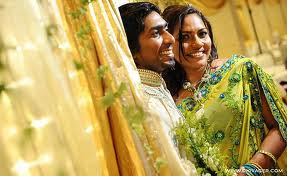Wedding traditions vary across religion, caste, ethnicity, language, region, etc. Traditional Indian weddings are generally structured into pre-wedding ceremonies, wedding day ceremonies (consisting of the Baraat, the Varmala and the Satphere), and the Vidaai. When the marriage has been agreed upon, the father of the bridegroom visits the father of the bride. The day before the expected arrival of the marriage procession, lavish preparations are done by the family to receive the groom (shaadi ki tayaari) in beautiful and decorated venues, typically farmhouses or hotel halls, where a sacrificial fireplace called marhwa is built. Brides decorate themselves by wearing gold and diamond jewellery, apply [mehndi] to colour hands and feet, and undergo various bridal makeups, including wearing bridal lehenga or saree. Bridegrooms typically wear a [sherwani] dress or a designer suit. To complete the marriage, the bride and groom move in circles around the sacrificial fire, called phera.
Vidaai is when the bride is formally sent to the groom’s household. It can get quite emotional even for the most stonehearted. Many heart-wrenching songs have immortalized this moment when the bride leaves her ‘babul ka ghar’ or father’s house.
An example of the complexity of an Indian wedding can be seen from the various phases of a wedding in North India. The following events take place in a typical Eastern Uttar Pradesh Hindu marriage:
According to Hindu religious texts, Brahma created man from the right shoulder and woman from his left shoulder. A woman is referred to as Vamangi or one who is on the left side. Throughout the marriage ceremony the bride sits on the right side of the groom. That is the place for strangers and acquaintances. Only after the Saptpadi, when the bride and groom have exchanged marital vows, is the wife seated on the left side of the man.
The bride and groom are told about their duties and responsibilities in married life by priest. These vows direct the couple to a positive path of action. They help in promoting marital happiness for a lifetime.
Vows by the Husband
- I will consider my wife to be The better half. I will look after her just as I look after myself.
- Accepting her as in-charge of my home, I shall plan things in consultation with her.
- I will never express dissatisfaction about any shortcomings in my wife. If there are any, I will explain them to her lovingly. I will support her in overcoming them.
- I will always have faith in my wife. I will never look at another woman with wrong intent, nor have an illicit relationship.
- I will be affectionate and treat my wife like a friend.
- I will bring home all my income to my wife. The household expenses will be incurred with her consent. I will always make an effort to ensure her comfort and happiness.
- I will not find fault or criticize my wife before others. We will sort out our differences and mistakes in privacy by ourselves.
- I will have a courteous and tolerant attitude towards my wife. I will always follow a compromising policy.
- If my wife is unwell, or is unable to fulfill some of the responsibilities or through some misunderstanding behaves wrongly, I will not withdraw support or refuse to fulfill my responsibilities towards her.
Kanyadaan
During kanyadaan, the bride’s parents give their daughter away in marriage. The groom makes three promises – to be just (dharma), earn sufficiently to support his family, (artha) and love his wife (kama). He repeats these vows thrice in the presence of Agni (the sacred fire) and all who are gathered there.
Bariksha
Bariksha is when the bride's parents have informally shown intentions that they want a particular groom, and the groom and his family have agreed. Retracting at the end of this stage is frowned upon but is acceptable. Once the wedding has been decided on by both sides, the bride's family goes and does Badcheka/ Bariksha of the groom. This is when the bride's father and brothers go to the groom's side with sweets (including a coconut) and some pooja items like rice and turmeric. This ceremony is a token gesture to confirm the alliance and signifies that the groom is now "taken" and can no longer look for other prospective brides.
 Tilak
Tilak
Tilak involves the bride's parents traveling to the groom's family home to formalise the relationship. A large feast is organised by the groom's family to celebrate this occasion. Only a nominal number of members of the bride's family are present (usually only very close relatives, often in tens of numbers). Typically, the female marriage proposal is very rare. Lord Ganesha on an Indian wedding invitation card. Lord Ganesha is believed to bring prosperity and happiness to the marrying couple and their family.
Byaha Haath
Byaha Haath: This ceremony signifies the purifying of the mind, body and soul of bride and groom. This daytime ceremony prepares both of them for the nuptials. 'Uptan' is a mixed paste of sandalwood, turmeric and rose water which is applied by seven unmarried female members of the families to the faces, hands and feet of the bride and groom. After this ceremony the bride and the groom are not allowed to step outside the house before the actual wedding.
Flower bed ceremony
In the flower bed ceremony, the bride wears a lot of floral ornaments and the marriage bed is decorated with flowers by the groom's family. This is the night of consummation. In Muslim marriages, this takes place on the night of the wedding. In Hindu marriages, this takes place on the night of the reception.

No comments:
Post a Comment